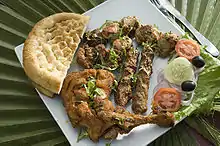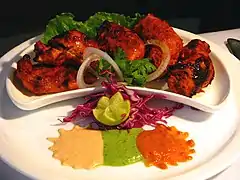 Fire-roasted papadam | |
| Alternative names |
|
|---|---|
| Course | Appetizer or side dish |
| Place of origin | India |
| Region or state | South Asia with region variations |
| Main ingredients | |
| Variations |
|
A papadam, also known as papad, is an Indian dough of black gram bean flour, either deep fried or cooked with dry heat (flipped over an open flame) until crunchy. Other flours made from lentils, chickpeas, rice, tapioca, millet or potato are also used. Papad is typically served as an accompaniment to a meal in India, Pakistan, Bangladesh, Nepal, Sri Lanka and the Caribbean or as an appetizer, often with a dip such as chutneys, or toppings such as chopped onions and chili peppers, or it may be used as an ingredient in curries.
Etymology
Papad is likely derived from the Sanskrit word parpaṭa (पर्पट), meaning a flattened disc described in early Jain and Buddhist literature.[1][2] Papad is known by several names in the various languages of India, e.g. appalam in Tamil; happala in Kannada; papadam (පපඩම්) in Sinhala; pappadam in Malayalam; appadam (అప్పడం) in Telugu; papad in Marathi,[3] Punjabi and Gujarati; and pampad (ପାମ୍ପଡ) in Odia.
Spelling and pronunciation
Some divergence of transliteration may be noted in the third consonant in the Hindi/Urdu word pāpaṛ (Hindi: पापड़, Urdu: پاپڑ). The sound is the retroflex flap [ɽ], which is written in Hindi with the Devanagari letter ड़, and in Urdu script with the Perso-Arabic letter ڑ. Although in ISO 15919 the Hindi letter ड़ is transliterated as <ṛ>, popular or nonstandard transliterations of Hindi use <d> for this sound. The occurrence of this consonant in the word pāpaṛ has given rise to two alternative spellings in English: papar (anglicized as "popper"), which reflects its phonology, and papad, which reflects its etymology.
Regional variations

Papad recipes vary from region to region and from household to household. They are typically made from a flour or paste derived from lentils, chickpeas, black gram, rice, or potatoes.
Salt and peanut oil are added to make a dough, which can be flavored with seasonings such as chili, cumin, garlic, or black pepper. Sometimes, baking soda or slaked lime are also added. The dough is shaped into thin, round flatbreads, dried (traditionally in the sun), and can be cooked by deep frying, roasting over an open flame, toasting, or microwaving, depending on the desired texture.
Bikaner is the hub of chickpea and green gram papad manufacturing. Potato papad is made in Varanasi. Most sweet- and snack-selling national companies are also involved in this business. In the north, papads made in the city of Amritsar and its surrounds are especially famous. The Lijjat Papad company, headquartered in Mumbai, is a major manufacturer, and is often cited as an exemplar of the women's empowerment movement in India, as it is run entirely by women.
In most Indian restaurants around the world, they are served as an appetizer with dips, which often include mango chutney, lime pickle, onion chutney, and raita.[4] Masala papad with sev, onion, tomato and coriander leaves is one of India's most popular appetizers.
Ingredients and preparation
Papadam can be prepared from different ingredients and methods. Arguably, the most popular recipe uses flour ground from hulled split black gram[5] mixed with black pepper, salt, a small amount of vegetable oil and a food-grade alkali, and the mixture is kneaded. A well-kneaded dough is then flattened into very thin rounds and then dried and stored for later preparation and consumption. It may also contain rice, jackfruit, sago, etc., as main ingredients.
Cracked black pepper, red chili powder, asafoetida, cumin or sesame seeds are often used as flavoring agents. Papadam is also made from rice flakes, ragi or horsegram.[6]
Gallery
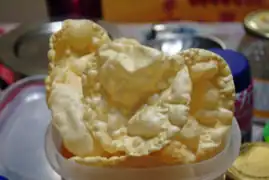 Kerala pappadam
Kerala pappadam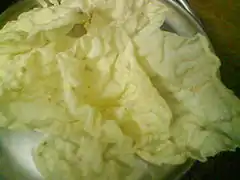 Rice papadam
Rice papadam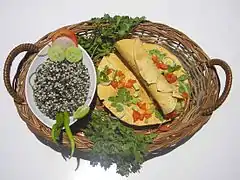 Uradal papadam
Uradal papadam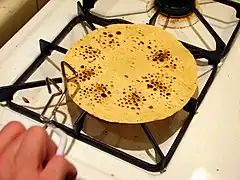 Fire-toasting papadam
Fire-toasting papadam A Nepali thali with papad
A Nepali thali with papad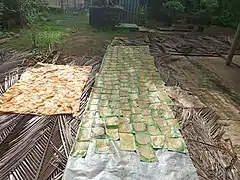 Raw jackfruit papad in coastal Karnataka
Raw jackfruit papad in coastal Karnataka Papadams with chutney are often served as an appetizer at South Asian restaurants around the world.
Papadams with chutney are often served as an appetizer at South Asian restaurants around the world.
See also
- Indian bread – Wide variety of flatbreads and crêpes which are an integral part of Indian cuisine
- Sandige – Fried snack, originating from the Indian subcontinent
References
- ↑ "Poppadom - Definition and synonyms of poppadom in the English dictionary". educalingo.com. Retrieved 22 September 2021.
- ↑ "Lip-Smacking Ways to Use Papad: From Masala Papad to Rolls and Chaats". NDTV Food. Retrieved 12 September 2022.
According to food historian and author KT Achaya, "The parpata (papad) is first mentioned in about 500BC in Buddhist-Jain canonical literature, and the medical authorities note that they are made from pulses like urad, masoor, chana and the like."
- ↑ Khedkar, Renu; Shastri, Pratima; Bawa, Amarinder Singh (2016). "Standardization, Characterization and Shelf Life Studies on Sandge, a Traditional Food Adjunct of Western India". International Journal of Environment, Agriculture and Biotechnology. 1 (2): 237–243. doi:10.22161/ijeab/1.2.18.
- ↑ "Poppadom Dips Recipe (easy Indian dips)". 23 May 2023.
- ↑ J. Smartt; Emmanuel Nwokolo (6 December 2012). Food and Feed from Legumes and Oilseeds. Springer Science & Business Media. p. 28. ISBN 978-1-4613-0433-3.
- ↑ "Poha papad,Rice flakes Papad, Summer Recipe". Udupi-Recipes. 11 March 2018. Retrieved 9 January 2020.
External links
 Media related to Papadams at Wikimedia Commons
Media related to Papadams at Wikimedia Commons

